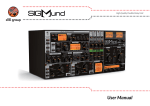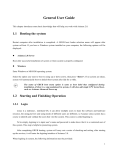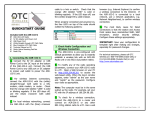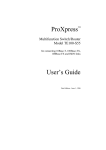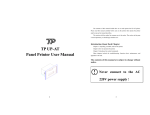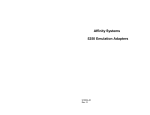Download SWP-ASR series T F T enhancement paperless recorder user manual
Transcript
22 00 00 88( (V Veerrssiioonn 11) ) Charm Faith Autosystem Instrument S W P-A S R se r i e s T F T enhancement paperless recorder use r manual 香 香 港 港 昌 昌 晖 晖 自 自 动 动 化 化 系 系 统 统 有 有 限 限 公 公 司 司 C CH HA AR RM M FF A A II TT H H A AU U TT O OS SY YS S TT E EM MC CO O .. ,, LL TT D D .. -1- Swp ® is CharmFaith Autosystem trade mark. Charm Faith instrument copyright. Shipping detail Dear customer, Appreciate you use Charm Faith SWP-ASR100 series paperless recorder. Please check the shipping items included. Any issue, please contact our service center or distributor. We will great to provide our best service! Shipping items Qty SWP-ASR100 paperless recorder 1 SWP-ASR100 user manual 1 Installation fixing 2 Power filter modutor 1 Product certificate card 1 Product warranty card 1 Overview In order to correctly use SWP-ASR series, please read carefully this operating manual. For safety reason, grounding is very importance. After finishing the installation, confirmed that power lines have connected correctly otherwise the instrument outer covering might be with approximately 110 V. Communication ports connection should be under power off condition. Please do not disassemble the instrument. Contact company service center or the local business agent if the instrument is breakdown. Please maintain the instrument surface clean with soft dry cloth. The gasoline or alcohol and any organic solvent are not allowed for surface cleaning. -2- Index 1 PAPERLESS RECORDER OUTLINE ............................................................... - 5 1.1 FEATURE................................................................................................... - 5 1..2 DATA SAV ING MODE ........................................................................................ - 7 1.2.1 Internal data saving ....................................................................................... - 7 1.2.2 Data transferring ........................................................................................... - 7 - 1.3 ALARM ........................................................................................................ - 7 1.3.1 Alarm modes................................................................................................. - 7 1.3.2 Alarm marks ................................................................................................. - 8 1.3.3 Alarm outputs ............................................................................................... - 8 - 2 INSTALLATION AND WIRING...................................................................... - 10 2.1 ATTENTION ............................................................................................... - 10 2.2 INSTALLATION ............................................................................................. - 10 2.2.1 Environment ............................................................................................... - 10 2.2.2 Diamension................................................................................................. - 10 2.2.3 Installing .................................................................................................... - 11 2.2.4 Terminal description ..................................................................................... - 11 2.2.4.1 Terminal ....................................................................................... - 11 2.2.4.2 Linear input wiring diagram ............................................................. - 12 2.2.4.3 Multiple terminal diagram ................................................................ - 12 2.2.4.4 DC-24V Power output diagram ......................................................... - 12 2.2.4.5 Replay output terminal diagram........................................................ - 12 2.2.5 Wiring description ........................................................................................ - 12 2.2.5.1 Power connection ........................................................................... - 13 2.2.5.2 Input signal connection ................................................................... - 13 2.2.5.3 Comm connection........................................................................... - 14 - 3 OPEARTING ................................................................................................. - 16 3.1 POWER ON ................................................................................................... - 16 3.2 KEY PADS OPE RATING ...................................................................................... - 17 3.2.1 Brightness adjustment .................................................................................. - 17 3.2.2 Display modes ............................................................................................. - 18 3.2.3 Curve and real time date printing ................................................................... - 18 3.2.4 Conf iguration setting .................................................................................... - 18 3.2.5 Time DIV .................................................................................................... - 18 3.2.6 Curve amplitude .......................................................................................... - 19 -3- 3.2.7 Display manu .............................................................................................. - 19 3.2.8 Alarm ......................................................................................................... - 20 3.2.9 USB f ile transfer ......................................................................................... - 20 3.2.10 Screen lock ............................................................................................... - 20 - 3.3 INSTRU MENT STATU S DISPLAY SUMMARY ................................................................ - 20 4 OPERATING DESCRIPTION ......................................................................... - 22 4.1TREND(MAIN PAGE) .................................................................................... - 22 4.2 ALARM INFORMATION ...................................................................................... - 23 4.3 SINGAL CHANNE L .......................................................................................... - 23 4.4 DUAL CHANNELS ............................................................................................ - 24 4.5 WHOLE CHANNE LS .......................................................................................... - 24 4.6 ALARM LOG .................................................................................................. - 24 4.7 BARGRAPH MODE ........................................................................................... - 25 4.8 POWER FAILU RE LOG 4.9 GENERAL OPE RATING DESCRIPTION...................................................................... - 27 4.10 HISTORY DATA RECALL ................................................................................... - 25 4.11 INSTRU MENT CONFIGU RATION DISPLAY MODES ...................................................... - 29 4.12 ON LINE HELP ............................................................................................. - 30 5 CONFIGURATION SETTING ......................................................................... - 30 5.1 GOTO CONFIGU RATION SETTING ......................................................................... - 30 5.2 CONFIGURATION AND PARAMETER ....................................................................... - 31 5.2.1 System ......................................................................................................... - 31 5.2.2 Channels ...................................................................................................... - 32 5.2.3 Display ......................................................................................................... - 35 5.2.4 Comm conf iguration ....................................................................................... - 35 5.2.5 Printer configuration....................................................................................... - 35 5.2.6 Purview management ..................................................................................... - 36 5.2.7 Linear output ............................................................................................... - 39 - 6 COMMUNICATION ....................................................................................... - 40 6.1 COMMUNICATING CONNECTION........................................................................... - 41 7 MODULE AND SUFFIX CODE ................................................................................ 8 MAINTAINANCE ......................................................................................... - 42 8.1 CONNECTION INSPECTION................................................................................. - 42 8.2 OPERATING ENVIRONMENT ................................................................................ - 42 8.3 REPLACE SPOILT FUSE ...................................................................................... - 43 8.4 CALIBRATION ................................................................................................ - 43 8.5 CHANGE BATTERY ........................................................................................... - 43 -4- Chart recorder 1.1 Features 1.1.1 Input & Output Analog Input T.C: B、S、K、E、T、J、W RTD: PT100、CU50 DC: 0-5V, 1-5V, 0-100mV, 0-20mV, 4-20mA Input signal Pulse Input Rectangular, sine or triangular wave: Amplidute Range>= 4V, frequency 0 - 15KHz Analog output DC Current: 0-10mA, 4-20mA DC Voltage: 0-5V, 1-5V Output Signal Relay contact Relay: 220V/3A or DC 24V/5A rating SCR: 400V/0.5A SSR: 6-9V/0.05A Power Output DC 24V/30mA 1.1.2 Performance Accuracy Range Sampling Period 0.5%FS±1digit or 0.2%FS±1digit (ignored level: 0-25.5%FS) .-1999-999999 0.5 second Interrecord Time 1 second - 4 minutes Display mode High resolution, brightness adjustable, wide view angle and bright TFT Parameters setting By Key nods or upper linking computer setting. Security lock function is available Alarm 4 alarm points per channel are available. Upper/lower alarm, rate-of-change and differential limit; Alarm output delay, alarm delay high to low, external connection sound available, max 12 latest alarm messages are saved per channel. RS-232,RS-485: Buad rate 1200 – 115200 bps. color LCD (320x234) with saving screen (5.6” for ASR100 series) Communication port Control action Hysteresis ON/OFF relay output (AC220V/3A) is selectable. Printer Operating environment TPμP-A40 micro printer is recommended. Supply Voltage 95 - 260VAC 50-60Hz Power consume ≤ 20W Weight Approx 3000 g (ASR100 series) Ambient Temperature -15 — 45 ℃, Humidity ≤ 85%RH -5- 1.1.3 Memoey (Flash) capacity vs channel number, interrecord time and approx recording date : Capacity(Mbit) Interrecord time (S) Channel Number Approx recording date 10 1 2 4 8 12 683 341 170 82 55 1 2 4 8 12 1 2 4 8 12 1 2 4 8 12 1 2 4 8 12 16401 8200 4100 1984 1322 1366 682 340 164 110 32802 16400 8200 3968 2644 3415 1705 850 410 275 1 2 4 8 12 82005 41000 20500 9920 6610 32 (Default configuration) 240 10 64 (Extened) 240 10 128 (Extend) 240 Input type and measuring range: Input VDC IDC DI Mode Measuring range 0~20mV Input Mode Measuring range -9999~99999 S -50.0~1769.0℃ 0~100mV -9999~99999 B -50.0~1820.0℃ 0~5V -9999~99999 K -50.0~1372.0℃ 1~5V -9999~99999 E -50.0~1000.0℃ 0~10mA -9999~99999 J -50.0~1200.0℃ 4~20mA -9999~99999 T -199.90~320.00℃ On/off on/off Wre 3-25 0.0~2300.0℃ DCV input OFF:2.4V below Pt100 -200.0~850.0℃ (TTL) ON:2.4V above Cu50 50.00~150.00℃ TC RTD -6- 1.2 1.2.1 Data saving mode Internal data saving Nand Flash is used in the recorder. No battery is needed. It is safety for power incidently failure.) No distortion from recordered data as the data was saved as 16 bits. Figure 1-2-1 Max min 1 minute (1 pix) 30 minuts (30 pixes) Fig 1-2-1 1.2.2 Data transferring Normal U drive (2.0 versions) is used for data transferring. 1.3 Alarm 1.3.1 Alarm modes (Refer to the following table, 6 of alarm modes) Upper limit: LED turns to red and ―H‖ mark is display Measured value besides real time reading when alarm activated. It will return to green and ―H‖ mark disappears after alarm relieving. Alarm value Hysteresis Alarm output ON Figure 1-3-1 Lower limit: LED turns to red and ―L‖ mark is display besides real time value when alarm activated. It will Alarm output ON return to green and ―L‖ mark disappears after alarm relieving. Figure 1-3-2 Alarm value Measured value -7- Hysteresis Rate-of-change upper limit When the rising rate of change is great to the designated Measured value value, the alarm activated. Alarm mark ―R‖ display and Tmax value will turn to red. Value will return to green and ―R‖ Tmin Rising rate Interval disappears after alarm relieving. Figure 1-3-3 Rate-of-change lower limit: When the droping rate of change is slight to the designated value, the t 1 t 2 111 111 Time Measured value alarm activated. Alarm mark ―r‖ display and value will Tmax turn to red. Value will return to green and ―r‖ disappears Tmin Droping rate Interval after alarm relieving. Figure 1-3-4 t 1 t 2 111 111 Time Differential upper limit: When value is higher than Measured value the user setting’s, the alarm activated. Value will turn to red and ―h‖ mark will display. Value will return to green Differential Hysteresis and ―h‖ will disappear after alarm relieving. The setting value may be other channel’s output or user designated. Contrast value Figure 1-3-5 Differential= | Measured value – contrast value| Alarm output ON Differential lower limit: When value is lower than Alarm output ON the user setting, the alarm activated. Value will turn to red and ―l‖ mark will display. Value will return to green Contrast Hysteresis and ―l‖ will disappear after alarm relieving. The setting value may be other channel’s output or user designated. Differential Measured value Figure 1-3-6 1.3.2 Alarm marks To confirm alarm, press ― ESC ―, the real time measuring value will return to normal and alarm mark will disappear. 1.3.3 Alarm outputs Sound or signal alarm is available. User can select the relays output and connection is as below. -8- J1 Grp 4 Grp 3 Grp 2 Grp1 J2 Terminal 2 J3 J5 Normally open relays J4 Normally close relays Notes: Maximum 12 normally open relays or maximum 8 normally close relays output can be configurated in the ASR-100 chart recorder. -9- 2. Installation and wiring 2.1 Attention: 2.1.1 Attention in instrument using There are many plastic parts in this instrument panel. Please do use dry soft cloth for cleaning. Solvents are not allowed for cleaning. Please keep the LCD screen away from any sharpen goods. Please keep any mechanical impact away during the instrument working. It might cause internal component damage or system breaks down. Turn off the power for any maintenance if necessary. Please contact our customer service department or local dealer if any unusual sound, belches smoke or unusual smell was found. 2.2 Installation 2.2.1 Envirom ent To ensure the instruments be normal working, non-strong interference control panel is strongly recommended to be installed on and the panel steel plate thickness should not be lower than 4mm. The instruments operating ambient temperature: -15℃ - 60℃, humidity: 10% - 85% (without condensation) is recommended. Please keep away from the direct sunlight, the multi-steam, the multi-caustic gases and the source of the electromagnetism environment. 2.2.2 Install Diamemsion – ASR100 (unit: mm) Front view Side view - 10 - 2.2.3 Installation (Figure 2-2-2) Thickness≥4mm Install diamemsion Rare view Tightening screw Clamp strip Figure 2-2-1 开孔尺寸 Face out #2 ternimal #1 terminal 2-2-2 Thickness≥4mm Clamp strip 2.2.4 Terminal description Terminal arrangements are descripted on Figure 2-2-3-A and Figure 2-2-3-B. Signal input / Control output: Input/Output terminal symbol Description L、N、G Power terminal and Grounding A、B、C Analog input terminal,Max 12 channels (ASR100) P+、PJ DC24V Power output terminals, Max 6,30mA each,for converter power supply Relay output terminals, Total 12,relay: 250VAC,3A 2.2.4.1 Terminal Com Port L N G Power Supply #2 terminal 1 6 #1 terminal - 11 - 2.2.4.2 Analog input wiring diagram A Terminal 1 Maximum 12 channels input will be available. B C # # # # # # # # # # # 12 11 10 9 8 7 6 5 4 3 2 1 # 2.2.4.3 Multiple terminal diagram Multipling terminal Universal input channel #9 to #12 can be set to for multipling terminals as special signal input terminals. In this case, the maximum universal input will be 8 channels. Terminal 1 2.2.4.4 DC-24V power output diagram +24V Power output Terminal 2 2.2.4.5 Relay output terminal wiring diagram #4 #3 #2 #1 Terminal 2 Figure 2-2-3-B Terminals - 12 - 2.2.5 Wiring description 2.2.5.1 Power Connection × 1、L (Line), N (Nuture), G (Ground) × × 2、Before wiring inputs ensure power supply is correct. 3、Input wiring must be under power off condition. AC90-260V 2.2.5.2 Input signal connection Analog input signal connection and wiring are shown as Figure 2-2-4 and 2-2-5,Converter connection is shown as Figure 2-2-6. - remove terminal cover - For your convenient, wiring should be from low to high - Connecting all cable lugs with power off condition - Recover it after completing Plastic cable lugs (4mm) (The following wiring is an example for single loop input. Other each is similar. Current input RTD input Voltage output T.C input - 13 - Frequency output Figure 2-2-4 Analog input diagram 2 wires transmitter Figure 2-2-5 Frequency input、transmitter wiring diagram 3 wires transmitter 4 wires transmitter Figure 2-2-6 Transmitter wiring diagram 2.2.5.3 Communication wire connection 1、 RS-232C connection The RS-232C port is at the back of the instrument.(Figure 2-2-7-A and 2-2-7-B) ,It can be used for both data transferring with computer and serial printer as well. The transmission line should use the shielded twisted pair, the length should be less 10 meters. RX TX GND Figure 2-2-7A RS-232C com between computer and instrument - 14 - RX TX GND Figure 2-2-7B RS-232C com between printer and instrument 2、 RS-485 Com connection By using RS-485 communications with the computer, communication converter (RS232 to RS485) is needed. See Figure 2-2-9. The RS-485 transmission line should use the shielded twisted pair. When the baudrate is up to 19200bps, the maximum transmission line will be less than 1000 meters. In order to reduce the signaling and the echo trouble, please install 120 ohm terminal resistances in the both sides of transmission line. (e.g. Figure 2-2-8) Com converter 120ΩTerminal resistor DATA(+) 120Ω Terminal resistor DATA(-) Figure 2-2-8 485 Com connection diagram - 15 - DATA (-) DATA (+) Figure 2-2-9 Com convertor to instrument RS485 connection 3 Operating 3.1 Power on Turn on the power with the grounding. (Default configuration is 220VAC). (First time power on is suggested that do not connect any input). After 4 Seconds initialization, below status will be seen. Figure 3-1-1 - 16 - 3.2 Key pads operating There are 14 function kays as 3-1-1 shown. Channel selection Left/Right shift. Change display modes. ENT For confirming the function or selecting menu; ESC Escape from the current operation; DIV In the main and history recall page, 4 grades of time/div can be selected; SET F1 F2 Press“SET”+“ " goto instrument configuration setting; “F1”is a special function key. It will combine with other keys and perform some special functions. It will descript later; “F2” is another special function key. It will combine with other keys and perform some special functions. It will descript later; “Lock” key is for the parameter setting protection. LCD right up site will show the locking mark. Unlock status, the display will be back to default automatically after non-key PD PRINT touching 4 mins; ―PAGE DOWN”key is used for channel pages (group) display switching. Print +“F1” will print out channels real time data or curve selectable. It is for the brightness adjusting. 3.2.1 Brightness adjustm ent Press , as Figure 3-2-1 shows, & key will be able to adjust brightness. Press ESC to save the setting and back to system. 30 grades are available for setting. Higher is brighter. Figure 3-2-1 - 17 - 3.2.2 Display m odes - As Figure 3-2-2 shown, Press― ‖to select the display modes. - Press ― ENT ― and select by manu. Figure 3-2-2 Figure 3-2-3 3.2.3 Curve and real time data printing Press ― PRINT ‖, you can see printing setting. As Figure 3-2-3 shown, you can select related CH of curve or data with start and end time for printing. Users can also press ― channels data. The communicating status will see and PRINT ‖+― F1 ‖to print all alternate twinkling. 3.2.4 Configuration setting Press“ ”, will see “PUR password”as Figure 3-2-4. Press “ ”shift forward SET ”+“ and press“ ”shift back ward. Press“ ENT ”to change user’s name and “ ” or “ ”to change the password. 3.2.5 Time DIV Figure 3-2-4 Under trend, single CH and History recall display, press“ DIV ”will change display curve time division rate. Refer to Figure 3-2-5. DIV = Interrecord time* Time indice DIV =Interrecord time* Time indice Figure 3-2-5 - 18 - 3.2.6 Curve amplitude Under trend, press“ ENT ”to manu, Option Group curve range setting will be 0-100%. It can be set to e.g. 20 – 80% accordingly. Curve upper limit is 100% Curve lower limit is 0% Figure 3-2-6 3.2.7 Display menu Under system display, press“ENT”goto display menu. There are total 3 levels menu as shows in Figure 3-2-7. “ > ”mark is showing that there are more option in the menu of the following levels. 3rd level menu 1st level manu 2nd level menu Figure 3-2-7 Note: For some new revsion recorder, once the U drive inset into the recorder, it will active ―U drive option‖ functions: either to save data or to upload software from U drive. - 19 - 3.2.8 Alarm Red alarm mark twinkling is showns that alarm is activated. Press “ ESC ”the alarm mark will return to green and alarm relieves. Alarm activated Alarm relieves 3.2.9 USB data transferring Figure 3-2-8 SWP-ASR100 chart recorder is allowed normal U drive for data transferring. U drive detected No U drive detected Data transferring to U Figure 3-2-9 The data transfer completed when symbol changed color from red. 3.2.10 Screen lock Press “ ” lock the current display. Otherwise it will return back to Main automatically after 4 minutes duration without operating. Unloack 3.3 Instrument status display summary Figure 3-2-10 - 20 - Current display group number: Red is for auto-inspection. Display mode Date and time Com Port porticon-No Y-M-D H:M:S communication happened Twinkling is for alarm Com Transmission happening. Press relives ESC to alarm and back to normal. Com Receiving No alarm or alarm relieves if green symbol twinkling. U drive detected. Do not Locking interrupt it unless data Main display). icon (except transferring is completed COM port icon U drive is ready for data transferring or Data transferring is completed. COM port Data transmission Data receiving Data transferring U drive is in progress. ** Interrupt will damage U drive or corrupted data. - 21 - 4 Operating description SWP-ASR100 is a TFT with system configuration and help function(included: multi-channels main display, alarm display, single/dual/whole channels displays, bar graphic, history recall and even log as well. 4.1 Trend Trend display is shows as Figure 4-1-1. It is included bar graph and channel real time data as well. Display mode Current Group USB icon Date and Time COM icon 系统日期、时间 Time div Bar Graphic Curve Marker Scale CH No. Grid Alarm mark Real time data 实时测量数据 Special marker Eng Unit Figure 4-1-1 模拟曲线标志 Key operating ` Move the cursor to individual channel for function mark option. Change display mode, by using keys to select the ON/OFF of curve display Change channel display mode - 22 - Vertical diplay, real time readings are in different display mode. Figure 4-1-2 Figure 4-1-3 4.2 Alarm information It displays 4 alarm modes for all channels. H: Upper limit alarm L: Lower limit alarm J3: Action relay number. 4.3 Single channel Figure 4-2-1 Figure 4-3-1 is a single channel display mode. It will include real time data, display curve, bar graphic and alarm status as well. Measuring data will change to red color once alarm to be activated. Alarm mode Display mode Unit Date & Time CH No. Measuring data Alarm mark Time DIV Bar graph Grid Curve Figure 4-3-1 - 23 - 4.4 Dual channels Display mode Date & Time 1st CH Unit 1st CH No. 1st CH Measuring data 2nd CH No. 2nd CH unit 2nd CH Measuring data Alarm mark 4.5 Whole channels Figure 4-4-1 Date & Time Display mode Unit CH No.s Alarm mark 4.6 Alarm log Real time data Figure 4-5-1 The latest 12 alarm messages per channel are saved in alarm log. The messages are included alarm happening/relieving time, alarm channel number, alarm points and alarm mode as well. Alarm mark turn to red, it means alarm is happening, green means alarm is relieving. Display mode Date & Time Number of alarm Alarm happening time Alarm type Number (L:Lower limit、 H:Upper limit) Alarm mark - 24 Figure 4-6-1 4.7 Bargraph mode Bargraph display can be separated into 6 groups and maximum 8 channels per group. As shown in Figure 4-7-1. It can be in both vertical and horizontal display mode. Shows in Figure 4-7-2. Group number Display mode Date & Time CH No. Upper range Alarm mark Scale % Bar graphic Lower range Alarm level Real time data Unit Figure 4-7-1 Figure 4-7-2 Figure 4-7-3 4.8 Power failure log It displays the instrument power failure (off) record information. It included: total number of power failure (off), duration per power failure (off) and total power failure (off) accumulating time. There are maximum 11 messages per display. Refer to Figure 4-9-1. - 25 - Display mode Date & Time Sceen locks Current page record #/ total # of power failure (off). Power off duration Alarm number Total # of power off Accumulating time 掉电总时长 Figure 4-9-1 4.9 Operating description: (General operating) DIV There are 4 options in time DIV display mode Move cursor on channel display mark CH disables or enable in CH operating mode After ESC, it is for display page up and down; ESC PAGE DOWN Drawing back from any setting; - Change CH group page; (display) - Switch to next of 11 power failure record if have; (PF log) - Terminal connection mark and wiring diagram; (wiring) - Switch to next 12 of alarm record if have. (alarm log) ENT PRINT Go to manu; For history data printing and + F1 for channels real time - 26 - data printing. SET + F1 + Go to configuration setting. Help on line. Brightness adjusts. Screen locks mark. Screen locking mark. When screen locked, there is a lock mark display on right top corner. If the screen unlocking, the display will switch back to trend display automatically in 4 minuts if keys non-operating. 4.10 History recall The history recall trend is used for history data inspecting. It is similar with main display as Figure 4-8-1. There is a time period display under the real time for history recall trend. The value in the recall time period is displaied the measured value upper/lower limit. In the recall trend, the dashed lines expressed the recall locator axis, indicating the position of current recalls which the plot point locates. The recall displays are with stepping recall, continually recall and timer recall. by ― PAGE DOWN ―to display the group number, ― SET It can be switched ―to change the recall modes. Group number Display mode Date & Time Start、end time Interrecord time Scale % Partition line Curve Recording data Upper left: partion line CH No. of the maximum Lower left:Partition line Figure 4-8-1 of the minimum Operating and displaying description: - 27 - “ ‖ SET There are : Stepping recall, continue recall and timer recall according to ―recall modes‖ setting. “ ” “ ” Move cursor on channel display mark to select recall channel. “ ” 、 “ ‖ Enable / Disable CH ― ESC ‖: Escape from recalling function back to current relay status. Stepping recall Recall the curve either forward the locator axial, or moves a curve backward step by step. “ ” ENT “ ” Step: Alternate the curve localization axis for the dashed or the solid line. In horizontal display, curve will shift to left if the axis is dashed line, or, the localization axis shifts to left if the axis is solid line. “ ” In horizontal display, curve will shift to right if the axis is dashed line, or, the localization axis shifts to right if the axis is solid line. ― ‖ In vertical display, curve will shift to up if the axis is dashed line, or, the localization axis shifts to up if the axis is solid line. ― ‖ In vertical display, curve will shift to down if the axis is dashed line, or, the localization axis shifts to down if the axis is solid line. Continue recall: After the determination recalls the direction, the system recalls automatically according to the stipulation gap number migration. ― ‖ In horizontal display, curve will shift to left. Functional instructions change to << 01 ― ‖ In horizontal display, curve will shift to right. Functional instructions change to “ ” >> 01 In vertical display, curve will shift to up. Functional instructions change to ︽ 01 - 28 - ― ‖ In vertical display, curve will shift to down. Functional instructions change to ︾ 01 << 01 、>> 01 、︽ 01、︾ 01 are curve shifting directions. Number is the step number. Timer recall Input recall time period: Press― ENT ‖, there will be a window showing as below Figure 4-8-2: With and , cursor will select date and time location. With and will select corresponding date and time user would like recall to. ENTIt to confirm the recall period will follow the time setting. Figure 4-8-2 4.9 Instrument configuration It will include instrument hardware and software information: - Instrument mode number - Software version - Serial number - Flash space and recording duration capability - Circuit diagram Figure 4-10-1 Figure 4-10-2 - 29 - 4.11 On line help There are two parts of on line help. First part will display function and usage. Second part will display operating guide. Figure 4-10-3: Figure 4-10-3 Note:Under difference display, press F1 + will get on line help instructions. will show the next page if help instruction is more than one page. it ESC PAGE DOWN It will escape back from help function. 5 Configuration setting 5.1 Go to configuration setting 1) Enter the configuration setting display “ SET ”+“ ”will display PUR setting page as below. Figure 5-1-1 - 30 - 2) Selection Press“ ”or“ ”and “ ”select user and password the press ENT to edit the configuration setting of the system. 3) Edit the configuration Press ― ― to select the object and press ― ENT ― for editing. Figure 5-1-2 5.2 Configurations and parameters 5.2.1 System configuration As shows in below: the edit objects are: date, time, password, channel numbers, interval record time, time DIV, TC open circuit display, key sound ON/OFF and screen saving as well. Figure 5-2-1 - 31 - Name Setting range Description Factory Date yy - mm - dd Default Real time Time h:m:s default Real time Preset 0000000000 Password 00000000—9999999 9 No. of channels 1 – 12 Preset recording channels Real Interval time 1 – 600 S Interrecord time 4S Time / Div 1 – 4 (type) T.C Burnout Hold Goto beginning Goto ending Key sound On/Off Screen saver delay 0 – 60 minutes delay Screen saver modes Darkest darker dark slightly unavailable 1:Rate change as 1,2,4,8 2:Rate change as 1,2,8,16 3:Rate change as 1,4,8,24 4:Rate change as 1,4,16,48 Hold on the present value Display lower limit scale Display upper limit scale On: Key press with sound Off: Key press without sound Screen saver delay time setting (Screen saver activated after delay time if no key operating) Darkness level after screen saver activating 1 Up scale On 0 Minute Unavailable 5.2.2 Channel configuration - Channel input configuration setting - Alarm setting Figure 5-2-3 Figure 5-2-2 - 32 - Note:In alarm setting, NULL is no alarm available. ―H‖ is alarm upper limit;‖L‖ is alarm lower limit;‖R‖ is rate-of-change upper limit;‖r‖ is rate-of-change lower limit. ―h‖ is differential upper limit and ―l‖ is differential lower limit. Figure 5-2-3 For the differential alarm, presents a single direction arrow in the bargraph. The upper limit alarm arrow is upward and the lower limit alarm arrow downward. In arrow scope with green is for Figure 5-2-4 alarm safe, otherwise is alarm status with red arrow. Figure 4-7-3 To set ―differential‖ alarm, ―comprison value‖ is requested. “ ENT ”will display setting window as Figure 5-2-5 shown. “ ” 、 “ ”can be used for value setting in all channels. Figure 5-2-4 Figure 5-2-5 Name Setting range Channel Measuring range 1 – 16 RTD, T.C, Freq, Ⅱ、Ⅲ standard signal. cal -9999 – 99999 Description Parameter setting for related chane 选择所设置参数对应的通道号 Instrument input signal mode (can be special request) Measuring lower and upper range 0.0000 – 100.00 Tags number CH01 – CH12 Channel definition ―CH01‖—―CH12‖ Unit See―Engineering unit‖ Real time measurement engineering unit display ℃ Module Factory setting Real Real Filter 0.0 – 9.9 To stable measuring value 0 Decimal point 0–3 Decimal point for value display 1 Ignored level 0 – 25.0% To cut off small signal in % 00.0% Squre root Yes/No Result squre root process No Zero offset -9999 – 99999 0 value calibration 0.0000 P offset -9999 – 99999 Input signal proport offset 1.0000 Linear fiting No. of curves Curve linear fiting by sectors No - 33 - [ Note 1 ]:When T、S、K、J、E、B、W mode was selected, press ENT (Setting)‖ as shows in Figure 5-2-6. , there will be an ―TC_CTC Figure 5-2-6 If input signal is lower or higher than range setting, system will remind it. Engineering unit table Unit type Engineering unit Temperature ℃、℉ Pressure bar、mbar、mmHg、mHg、mmH2O、mH2O、kgf/cm²、atm、Pa、KPa、MPa Flow volume t/s、t/min、t/h、L/s、L/min、L/h、Kg/s、Kg/min、Kg/h、m³/s、m³/min、m³/h、Km3/s、 Km3/min、Km3/h、Nm3/s、Nm3/min、Nm3/h Weighth t、Kg、g Volume mL、L 、KL 、mm3、、cm³、m³、Nm³ Heat enegy KJ 、MJ、GJ、KJ/h、MJ/h、GJ/h、W、KW、MW、WH、KWH、KJ/s、KJ/min Electrical A、KA、mA、V、KV、mV R.P.M r/min Density PPM Distance um、mm、cm、m、Km Others Special request Hz、KHz、%、‰、us/cm、KN、CRN、CRV、PPB、%RH、%O2、mg/m3、PF/m、NTU、m3/day、 MΩ、ug/L、mg/L、CPS、PH、Kg/m3、mg/m3、 PF/m、%LEL、rpm、%Bar Description in the ordering *1 *1 Note:8 of unit setting are reserved for user in special requesting. Figure 5-2-12: User will be able to define their special units from ―def1 – def8‖ - 34 Figure 5-2-12 5.2.3 Display configuration “√” in below will be able to display in mode list. Figure 5-2-13 “ “ ” 、 “ ” 、 “ ” Fig 5-2-14 Left/right shift and select display mode Enable /disable display mode ” 5.2.4 Com port setting The following settings are included com type, instrument DE #, buad rate selecting, IP address. RS-485 19200 NAME COMMUNICATION TYPE ADDRESS Communication baud(bps) SETTING RANGE RS-232/RS-485 0 - 200 1200、2400、4800、9600、19200 CONTENTS PRESET VALUE The type of instrument can not be shows in Figure changed after leaving factory 5-2-26 The communication address of instrument Choose the buad rate of data transfer 1 9600 [*1] The reliable baud rate will be 19200 bps if instrument electro-optical isolation is used. [*2] Communication port 2, do not use the electro-optical isolation,the max baud rate is - 35 - 57600bps。 5.2.5 Printing configuration Print the recording data, curve and printer communication configuration parameter setting. Figure 5-2-15 and 5-2-16. Baud rate setting will be same as addressed communication configuration setting) Figure 5-2-15 Figure 5-2-16 TPμP-A40 micro Pinter is recommended. 5.2.6 PUR m anagement As Figure 5-2-17 shows: Purview mamagement is used for instrument password control and number of users. Higher level parameters can only accessed by administrator. Name Setting range description Setting DE # 001 - 200 Instrument com address 001 Buad rate(bps) 1200、2400、4800、9600、19200 Buad rate selected 9600 - 36 - Figure 5-2-18 Figure 5-2-17 Change password User can only change their own’s password. Administrator setting It provides to advance level user setting. As in Figure 5-2-19, Figure 5-2-20 Figure 5-2-19 1) Figure 5-2-20, click ―Operating record display‖, It will be show as Figure 5-2-21 Display mode Current time Event detail # of record & total of record Record # Event time Fig 5-2-21 - 37 - Note:System can display different mode of events by press F1 if events number is not enough to display in one line. 2) In Figure 5-2-20: It is selectable to click ―Disable power On/Off record‖, ― Disable parameter admend‖ 3) In Figure 5-2-20: If ―Limit user operating record‖ was selected, the record can only be accessed by purviewed user. Figure 5-2-20: It can reset the instrument’s recording data of ―curve‖, ―alarm‖ and ―user operating record‖. Figure 5-2-20 Figure 5-2-22 Figure 5-2-21: the advance administrator can create 3 sets of configuration backup file with referring time. User can restore instrument setting accordingly. The backup parameters can also be reset by pressing CANCEL . 1 Administrator setting It is only ―1# administrator‖ The highest purviewer)can access and change. It include: number of operaters, number of administrators, purview level and recorver initial user password. Figure 5-2-22 - 38 - Figure 5-2-22 Note:The total purview level is 10. “1# adaministrator” (The highest purview’s user) can set purview level for others. 5.2.7 Analog output configuration For analog output instrument, it will display the ―analog output‖ diagram. Figure 5-2-23 and 5-2-24 shows. The analog output V or I value can correspond channel sampling computing or flow rate result. The instrument display will be disable if no function of Analog output. With the function, the maximum channels will be only 8. The analog output will occupy maximum 4 input channel’s terminals from 9-12. The parameter refer to below: Name Setting range Analog output 1-4 Output modes Voltage, Current Setting the signal mode of linear output NULL、1 - 9 Setting the CH’s of linear output. NULL is no Sampling CH Description Analog output CH tags Factory setting Real value Real value NULL - 39 - output. Output range Corresponding Value type Corresponding value range 0 - 20 (mA) 、 0 - 5 (V) Analog output range setting.(Assume that in the scope to be possible to establish willfully Real value e.g. 2-3V or 0-10mA) Sampling、transient flow, instantaneous Analog output corresponding type Sampling heat energy. Corresponding CH’s value range of linear -9999 ——99999 output(For flow CH, it is the instantaneous flow rate, other’s areCH’s sampling value) Sampling measurement Zero offset Entire range Linear output zero offset 0.0000 P offset Entire range Linear output proportion offset 1.0000 [ Note ] Real output signal = Analog output * P offset + Zero offset Figure 5-2-23 Figure 5-2-24 Note:Maximum of analog output will be 4 CHs. The corresponding CH can be selected from ―CH01–CH09‖. Output mode will be Current (I dc) or Voltage (V dc). ―NULL‖ is not analog output function. 6 Communication SWP-ASR100A series will be able to communicate with computer by using RS-232C or RS-485. Either of them is selectable. The SWP-ASR100A series chart recorder management software is ready for user to remoting moniter, configuration setting, data transferring, and profile printing as well - 40 - 6.1 Communicating connection Notes: Communication connection or disconnection should be under instrument power off condition. Figure 6-1-0 7. Model and suffix code – Ordering information Model Spec. code Additional code description ASR101 ASR100 (1 ch) ASR102 ASR100 (2 ch) (standard configuration) ASR103 ASR100 (3 ch) ASR104 ASR100 (4 ch) ASR105 ASR100 (5 ch) ASR106 ASR100 (6 ch) ASR107 ASR100 (7 ch) ASR108 ASR100 (8 ch) ASR109 ASR100 (9 ch) ASR110 ASR100 (10 ch) ASR111 ASR100 (11 ch) ASR112 ASR100 (12 ch) Memory capacity Languages -1 32 Mb (default) -2 64 Mb -3 160 Mb -0 Simple Chinese -1 English -2 Traditional Chinese - 41 - -3 Specification Multi-languages /C2 RS-232 comm port *1 /C3 RS-485 comm port *1 /P(1-6) No. of DC24V Power outpot /AO(1-4) No. of linear output /F(1-4) No. of frequency input /J(1-12) No. of (Normally open) Relays /JB(1-4) No of (Normally open/close) relays /L Flow accumulating function (included report function) /T Nutual gas operating function (included report functions) /PID *2 *3 *3 PID control functions *1. One of /C2、/C3 can be selected,By using μprinter, must be RS-232 (/C2) port available。 *2. TPμP-A40 micro printer is recommended *3. If analog output or frequency input are selected, the maximum universal inputs number will be 8 (Please refer to manual detail) e.g.: ASR108-2-1/J4/C2 Instrument dimension is 144× 144× 240, 8 channels, English revision ASR chart recorder. With 4 relay outputs (normally open) and RS-232 comm port, 64MB internal memory capacity. Module Code Description SWP-ASR100A-PW □ Power supply board, 6x DC24V power output(0-6) SWP-ASR100A-AI □ Multi-channel isolation board(1-8) SWP-ASR100A-USB □ USB Memory(1:64Mb,2:128Mb) 8 Maintainance In order to ensure the instrument working properly, regular maintanence is necessary. 8.1 Connection inspection Ensure L、N、G power connection points are tighten.(Grounding resistance must ≤ 100 Ω) Ensure input signals wiring are properly contacted. 8.2 Operating environment Operating temperature:0℃—45℃;Humidity:10%—85%(without condensated) ; Please do not use the instrument under direct sunlight, high humidity, corrosive gases and strength electromagnetism conditions. - 42 - The front installation panel thickness should be ≥ 4mm Please install the instrument with carefully. 8.3 Replace spoilt fuse Steps: - Ensure power off the instrument - Disassemble the front panel with 2 screws under front cover. - Pull out the power board from the rack. - Replace fuse - Re-install. - Power up and check the working status. 8.4 Calibration Please ensure instrument calibration yearly. There are some calibration tools recommended: Standard DC voltage signal generator (Output: 20mV—20V Variable resistor (Output: 0.1—500Ω Accuracy ± 0.001% Accuracy ± 0.005%); Resolution 0.001 Ω). Calibration process: 1 Power up instrument with correct GND, warmup 30 minutes or above; 2 Ensure environments is instrument acceptable condition; 3 Input measurement points (0 ,50% ,100%) of measurement range, record down input value Vs measuring value; 4 Amend zero and P offset value in the instrument according the following formular. Measuring value1 × Proportion + Zero = calibrated value1 Measuring value2 × Proportion + Zero = Calibrated value2 8.5 Change battery The instrument backup 3.6V battery can be found on mainboard. It need to be replaced if clock dosen’t run when power is off. - 43 - Fuse on the power card Battery in main board 昌 晖 自 动 化 系 统 有 限 公 司 CHARM FAITH AUTOSYSTEM CO.,LTD. 香港中环红棉路八号东昌大厦十七楼 17th Floor,Fairmont House,8 Cotton Tree Drive,Central,Hong Kong Tel:00852-31190198 Web:http://www.swp.com.cn Fax:00852-25305488 Email: [email protected] - 44 -












































